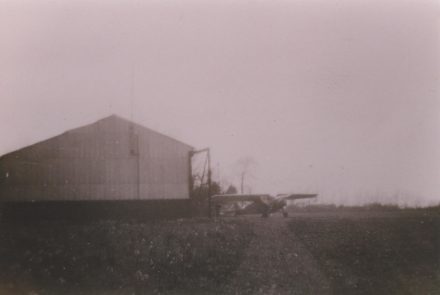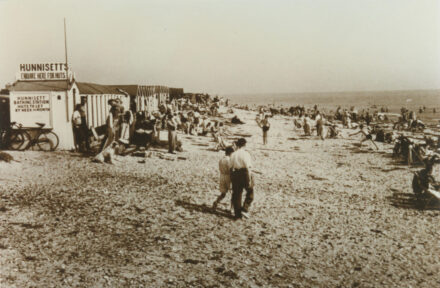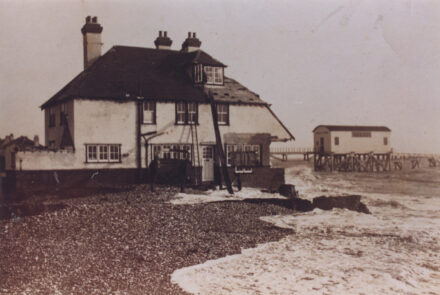While pondering on what to write about next, I thought I might take a look at Norton Priory so, with that in mind, I rummaged in the Selsey Society Archives and came across an auctioneer’s prospectus with a newspaper cutting tucked inside. It was from the Chichester Observer and was dated 18 June 1971 and the article was already written for me. The italics indicate the article, the normal font are my own comments.
Despite assiduous efforts to trace the author of the article and the owner of the photograph, I, West Sussex Record Office and the Chichester Observer Offices have drawn a blank. I therefore, yet again, have to apologise most humbly if I have infringed anyone’s copyright.!
THE AGE OF THIS BUILDING IS UNKNOWN
One of the oldest and most interesting buildings in the parish of Selsey, which is of great antiquity is the former Old Rectory, which was renamed Norton Priory at the beginning of the present century (i.e 20th Century)
Interesting notes in the possession of the present owner, Mr E Low-Beer, which have been prepared from documents in the archives at County Hall, Chichester, and from a number of reference books, including L F Salzman’s ‘Victoria History’, Samuel H Day’s ‘Selsey’s Old Rectory’, and Edward Heron-Allen’s ‘Selsey Bill’, give a great deal of valuable information.
Although it is generally agreed that the building is of medieval origin, so many alterations to it were carried out during the centuries that its development can only be conjectural. But most of the rebuilding appears to have been done in the 16th and 17th centuries.
CONFLICTING
It is doubtful if a single stone of the original edifice on the site remains, but there are conflicting opinions as to whether or not it was in fact St Wilfrid’s Clergy House.
One authority, J Dalloway, wrote: ‘Evident traces of a Roman military station have been discovered near the churchyard and the Rectory House in the tiles and bricks which have been worked in the wall’.
He also stated his belief that its ruins provided building materials for St Wilfrid and his priests when he founded and built at Selsey his Episcopal College of Secular Canons (Benedictines).
But other authorities do not agree with Mr Dalloway’s theory, believing that it was most unlikely that Norton Priory occupies the actual site of St Wilfrid’s Clergy House because in all probability it was built much closer to the now submerged cathedral .’
This is a popular Selsey myth – it is unlikely that the cathedral ever submerged because the coastline at Pagham Harbour has remained relatively unchanged over the centuries. William Reed, bishop of Chichester, stipulated in his will of 1 August 1382 that ‘my body to be buried in front of the high altar in the chancel of (the church of) the Holy Trinity at Selsey, formerly the cathedral church of my diocese.’ Fragments of Anglo-Saxon sculptured stone are built into the War Memorial and these are likely to have come from Church Norton.
On 22 October 1820, the Rev.Barré Phipps recorded in the Parish Registers ‘…the day after the full moon, the wind, being south and south-west, a remarkably high tide, accompanied by a violent wind, burst over the shingle bank of the sea, over the sea-wall, maintained by the Rector and by Mr George Copis, covered entirely the marsh belonging to both of them, and flowed into the farmyard of the Rector. The same thing happened on 23 November 1829 and again on 13 November 1840.
‘MOST LIKELY
It is thought that the most likely explanation is that Norton Priory is the restored fabric of the College of Chantry Priests of the first church erected at Norton after the loss of the cathedral, and of the rectory occupied by the earliest rectors of the parish.
Part of this early church was removed and rebuilt in Selsey as the present parish church in 1866.
The middle block of Norton Priory, which faces north and is about 30 feet in length, is probably the site of a timber-framed medieval hall, rebuilt with brick and heightened late in the 17th Century, while the foundations are of ancient stonework.
It is interesting to note that in several places in the exterior wall there can be seen herring-bone brickwork of a very early period.
PORCH
A low porch with a four-centred entrance is perhaps earlier, but the east and west wings, with gables in the front and set flush with the main wall, were built or rebuilt in brickwork early in the 16th Century and had stone windows and fireplaces.
A projecting fireplace in the north front of the west wing is now a recess, and a moulded stone Tudor fireplace has been reset in the central chimney stack. One of these fireplaces is carved out of Caen stone and is very similar to the tomb of John and Agatha Lewes in the churchyard, which leads one to suppose they were the work of the same stonemason.
In 1887 the Rector, the Rev. Prebendary Foster, stated in a paper which he read to the British Archaeological Society: ‘The west portion of this composite house is medieval. When, in 1864, I inserted in the south wall of the dining room on the ground floor a window of some size there was found to be embedded in the wall a small 15th Century (If not earlier) window. And next, to speak of both floors, dining room and drawing room, there is now in the north-west wall, but hidden by the battening, a considerable portion of two medieval fireplaces, each having a pointed arch.
Existence of two large fireplaces adjoining one another and a third fireplace on the west side seems to point to this room having been a large refectory for the community inhabiting the house.’
Other features of the west wing of similar date are the Caen stone quatrefoil ventilation at the top of the projecting closes or cell; the blocked four-centred stone doorway at the south end of the west wall, and the early 17th Century projecting chimney-stack with a chamfered brick plinth.
Although the east wing of the house is the least ancient part of the building its brickwork is old and approximately similar to the rest.
The interior of Norton Priory has been considerably renovated over the centuries. In the upper storey a 16th Century moulded oak door-frame opens on to the main staircase. The stair-hall behind the main block in the angle with the west wing is built of stone rubble and has a gable head, and is probably an 18th Century addition.
Adjoining the east side of the stair wing is a small porch and lower addition, probably 17th Century, and behind the east wing is a larger addition of the same period, which contained the former kitchen. It has a nine feet six inch fireplace at the south end with a cambered bressummer.’ (Acurved load-bearing beam in a timber framed building).
‘NOT KNOWN
There are no records to show when the house was built or when the living was established, though it is known that William de Loppedelle was rector of the church at Selsey in 1321, according to Samuel H. Day’s ‘Selsey’s Old Rectory’.
It is possible that Robert de Selsey, clericus, who visited Rome in 1279, was also a rector of Selsey.
Even in the 16th Century there was a great deal of doubt about the history of the Old Rectory. Typical of the fanciful romanticism which attaches to houses of great age is the explanation offered by the Rev. Ernest Malaher when he discovered two cells behind the dining room wall near the old stone fireplace in May, 1901.’
Through the kind offices of Sussex Past, the working name of the Sussex Archaeological Society, I have obtained a transcript of a note from F H Arnold, FSA, the then local secretary of the Society for Chichester, who was asked by Rev. Malaher ‘to go and look at some ‘finds’ which he had recently made in the Old Rectory, part of which is said to be thirteenth century and monastic. Behind the present dining room wall, he said, ‘we have opened two curious cells (one on the floor above), the old fireplace and a curious cupboard in the thickness of the wall. I should greatly like to know the probable use of the cells. Their purpose is a mystery; both were closed originally with heavy doors. The original fireplace is probably of Henry VIII’s time. The stonework is almost perfect.’ A Visit to Selsey did not enable me to elucidate the mystery as to the cells. One theory was that they were punishment cells for refractory monks and another that they were hiding holes; but why such exist in a rectory was by no means apparent.’
The unknown author of the newspaper article doubted this theory: ‘as in fact it was the parochial clergy who owned and lived in the house.’
‘It is possible that the true explanation could have been that these cells were used to hide smuggled goods, because the house was close enough to Pagham Harbour for this to be plausible, and it is known that a great deal of smuggling went on in the area during that period.
Confirmation of this explanation could be obtained, perhaps, from the fact that there was an underground passage leading from the old kitchen to the churchyard, the roof of which caved in some years ago.’
As we saw from the November 2014 article on Smugglers it has been recorded that Rectors of Selsey reputedly claimed a tithe on all kegs landed there, and stories tell of a passageway leading from the Old Rectory to the Mound. The course of the tunnel was marked by a depression on the surface of the ground as late as 1911. Heron-Allen, writing in 1911, asserted that the ‘depression’ is along the Priory carriage-drive. He also hopes ‘that this is fabulous, but there is no doubt that, as late as in the 18th century Selsey was, to some extent, a centre of the ‘Free Trade…’.

This picture of The Old Rectory is ca. 1890 according to a hand written note on the reverse.
‘Externally at least, Norton Priory has changed little since the 16th Century. In Lambert Barnard’s picture ‘the granting of the Charter by Caedwalla to St Wilfrid’ which now hangs in Chichester Cathedral, it looked very similar to what it does today.’ LambertBarnard also Lambert Bernardi (c.1485-1567) was an English Renaissance painter and the man in white looking over the left shoulder of the king is believed to be a self-portrait of Barnard. The Priory is to the immediate right of the cross on the left-hand side of the picture.

Image reproduced with the permission of Chichester Cathedral’
In August 1897, The Reverend Dr. and Mrs Storrs ‘graciously distributed’ the prizes for the sports which formed part of the Selsey Regatta at the Rectory. The sports had lasted until 7pm and the Rector stated ‘that he had never appreciated the attractions of Selsey more than on that day, as they stood there and saw the beautiful stretch of coast scenery, with Bognor in the distance.’
‘NAME CHANGED
The last rector who lived in the old Rectory was the Rev. W E Malaher, and when he resigned the living in 1902 it was sold for £2,000 to Mr Claude Bishop, who changed its name to Norton Priory.
The London Gazette of 11 March 1904 contains the ‘Instrument substituting the New Church of Saint Peter, situate within the parish of Selsey, in the county of Sussex, and in the diocese of Chichester, for the Old Church of Saint Peter, situate within and formerly having been the parish church of the same parish, but now pulled down with the exception of the chancel’.
A ‘new’ Rectory was built beside the New Church and this is probably what prompted the change of name of the old rectory to Norton Priory.
Some years later it was bought by Mrs. Levita, sister of Mr Duff Cooper, who later married Captain Wingfield. She carried out a great deal of rebuilding and alteration, including the present dining room and the main bedroom above, which constitute the south wing.
Stephanie Agnes Cooper married, firstly Arthur Levita in 1903 and they lived together at Norton Priory around 1913. Arthur died in 1910 and, in 1916, she married Maurice Ffolliott Rhys Wingfield. She died, aged 35, in 1918. She was the great-grandmother of David Cameron – yes THE David Cameron. After her death, Maurice continued to live there for a year or so.

‘Later (by 1920) the priory passed into the hands of Major Norman Holden and finally, in 1947, it was bought by the present owner, Mr E Low-Beer. (Remember the article was written in 1971!).
The grounds which surround the house contain traces of the old moat which existed centuries ago. There is also a fine collection of rhododendrons and azaleas as well as an old rockery reputed to contain some of the stones from the cathedral now covered by the sea.
Extensive lawns, with a background of an oak tree copse, the remaining remnant of the great wood which covered the area centuries ago, provide a perfect frame for a very picturesque old house.
An opportunity to see the gardens will be given when, at the invitation of Mr and Mrs Low-Beer, the Selsey Venture Club holds a fête on Lodge Field, which adjoins the grounds.’
On 22 November 1966, at 3 pm. Norton Priory was offered for sale, at the Dolphin and Anchor Hotel, Chichester by auctioneers Messrs. Knight, Frank and Rutley of London in association with Messrs. King & Chasemore of Petworth. A sumptuous prospectus was printed:

The ‘charming and historic’ property consisted of 9 principal bedrooms, boudoir, 6 bathrooms, 4 fine reception rooms, domestic offices, a garage block with 2 flats over, three detached thatched cottages, market garden, wood and paddocks extending to about 42 acres.

An undated letter from Knight, Frank & Rutley informed the vendor as follows:

The market garden of 4.21 acres sold for £4,500. This lot included a large range of timber and galvanised enclosed and open stores, a range of brick, timber and asbestos stores with water tower over, a lean-to range of greenhouses including a vine house and a peach house (25 ft long), a large span greenhouse and another double-span greenhouse.

And here is the photograph that came with the newspaper article.
More history of The Rectory is available from British History online www.british-history.ac.uk while www.rightmove.co.uk has some stunning colour pictures of Norton Priory.
And this is where the story ends – for now.
CHURCH NORTON REVISITED
Back in July I wrote about Norton Priory and this inspired John Ayling to write to me with his reminiscences. I am most grateful to John and would urge him to continue to write them!
‘Regarding the above estate, you are right, there were three thatched cottages – one was ‘The Lodge’ which was the top of the drive which is visible in your picture. Major Holden’s (the owner at the time) chauffeur lived there and his name was Mr Barron. The next cottage up the lane was called ‘Why Worry’ (now called Priory Cottage) and the last one further up the lane on the corner of Grange Lane was called ‘Priory Bungalow’ and I was born there in 1945. My father, Percy Ayling, lived there with my Mother Louisa and my two sisters Rosemary and Dian whilst my father was employed by major Holden as head gardener. Major Holden later on committed suicide…and my father took over and ran the market garden until all the estate was later purchased by Mr Low-Beer. I remember that about that time Mr Barron moved into ‘Why Worry’ and lived there to a good age with his wife. Mr Alec Vineall and his family moved into ‘The Lodge’ and I believe was Mr Low-Beer’s maintenance man. Behind ‘The Priory’ was a long sea wall which had peach, apple and pear trees growing along it when I was growing up and as children we used to go scrumping there. We all used to swim in the harbour and spent hours fishing there when Norton belonged to the ‘Locals’ – they were great days. My father worked there until his death in1968 and shortly after that time the estate was sold. Our Bungalow was sold for £3,000 and the other two were sold also… The gardens and bungalow were bought by Daryl Nelson-Smith and ‘The Priory’, complete with the copse and land, was later sold for £ 80,000.
If you look at your aerial photo of the harbour to the left you will see a small field with white boxes at the top of the field. If you wondered what they were – they were Bee Hives to provide the Priory with Honey’.

I also had a telephone call from Kevin Palmer who worked at Norton Priory as maintenance man when it was Norton Priory Care Home. He told me there was a massive swimming pool out by the woods which, in the late 1990’s, was in disrepair and therefore not used. There were rumours that the East Wing was haunted in the lift area but the present owner assures me that ‘my four little boys and I have been on many a ghost hunt and have so far been disappointed! I suspect my children make enough noise and mess to scare even the best intentioned spirits away.’
An email flooded in from Maya Ostrom telling me ‘ I remember my father telling me how he and his brother during the 1930’s, would sneak into the grounds to go bird nesting, often incurring the wrath of the gamekeeper!’
On 21 August 2012, The Lodge was up for sale and this beautiful picture is reproduced from the prospectus by kind permission of Chesterton Humberts, Estate Agents in Chichester.

And I am happy to report that the swimming pool here is in fabulous shape and housed in its own complex.
The grounds cover 5.26 acres and are absolutely stunning, as you can see.

I am extremely grateful to the current owners of The Lodge for giving me permission to share these pictures of their lovely home.
©Ruth C Mariner



